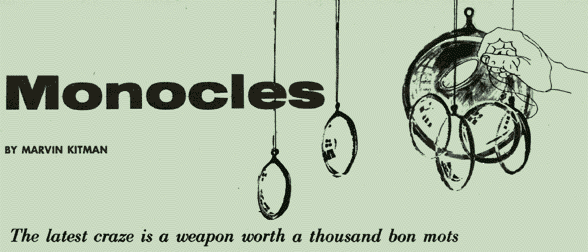
from
Escapades Carnival
1961
MILLIONS OF American men
lean on cigarettes and hang on to highball glasses to avoid falling down
in social situations. If you are one of them, why not switch to a monocle?
The avant garde college men currently reviving the monocle in the U.S.
are finding there is no faster way to gain self-confidence, poise and identity.
Even the most all-thumbs social caterpillar
can be transformed into a social butterfly with the aid of a monocle, which
is simply a glass lens fitted in a rim and anchored with a cord or ribbon
around the neck like a watch chain. For unlike the ascot, leather elbow
patch and Norfolk jacket, the monocle works in two ways at once: it changes
both your appearance and your personality.
By its very insertion between cheekbone and
brow, the monocle gives you a new interesting face. The keystone of the
new look is the sneer, due less to a state of mind than a muscle contraction
necessary to screw, so to speak, the monocle in the eye socket.
The social value of the sneer? Incalculable.
Where once you may have been able to enter
a jammed cocktail party without a soul taking notice, don't be surprised
if some over-imaginative woman now drops her Martini-glass at your mumbled
"Hello." It is impossible to ignore the bemonocled.
"Just looking at a man wearing a monocle I
am reminded of someone sinister-but pleasantly so," one such woman explained
recently. "He is mysterious--but not frightening. He gives the impression
of knowing everything there is to know. He looks like he is wearing a glove
of iron concealing a velvet hand, if you know what I mean."
With such a built-in advantage, a monocle-wearer
has little trouble establishing a personality the likes of which few cigarette
smokers and liquor drinkers can match. At once he has substance, prestige
and importance--yet wonderfully aloof, condescending and domineering. While
this personality pattern will earn you few Boy Scout merit badges, you'll
always have the upper hand in social relationships. They didn't call Erich
von Stroheim, an archetype monocle-wearer, "The Man They Love to Hate"
for nothing.
Properly used, the monocle is a social weapon
worth a thousand bon mots.
For example, one of the most elementary ploys
occurs in screwing in one's monocle upon being introduced to a woman at
a party. Where the usual introduction is often swamped by banalities, never
so in the case of the be-monocled. A long hard look at the women through
one's monocle will not be mistaken for politeness. (As an added fillip,
the monocle wearer can move his glance downward from the face. If that
doesn't make her feel like "September Mom," nothing will.) On the other
hand, raising the eyebrow and suddenly letting the monocle fall to the
full length of its cord will quickly show the wearer's disinterest.
While the monocle was first introduced in
England in 1800--a young actor wore one in a stage production as a substitute
for spectacles (then exclusively a seeing-device for the elderly) and the
monocle spread by contagion--it didn't arrive in the U.S. until 1880.
Known by several aliases ("oxfords," "dudes"
and "quizzing glasses" among them), it was used on and off through the
turn of the century here, but reached its peak popularity in 1913. Then
members of smart sets in New York, Chicago, San Francisco, Boston and Philadelphia
were wearing them to the man. So widely accepted was the monocle that even
bargain counters in drug and department stores featured them. (In hard
rubber and celluloid frames, they sold for as little as twenty-five cents.)
Until the current revival began, most Americans
have been content to leave monocles to older men, aristocrats, actors,
and Charlie McCarthy.
Today a monocle can be purchased at any large-sized
optician's, according to the Better Vision Institute, an optical trade
association promoting the use of eyeglasses. It can be bought with either
a prescription lens, for those who need optical correction (Napoleon used
to wear his monocle for myopia) and in a clear glass version called piano,
for those who don't. Several companies even make plastic lenses.
Monocles come in three major styles: framed
in plastic or metal (silver and gold-plate), framed with "galleries" added
(a top and bottom projection which makes it easier to wear) and unframed.
In the latter case, the lens itself is corrugated on the outer edges to
fit the eye socket better.
The most commonly used monocle is the black
plastic framed model selling for approximately $5, plus lens. The essential
cord or ribbon is extra, about $1. It is advisable to buy your monocle
at a reputable optician's because for best results they must be fitted
to the individual eye.
A novice monocle-wearer has little trouble
adjusting to his eye piece-provided he spends the time getting the hang
of it before he. wears it in public. Generally speaking, one must buy a
monocle before learning how to wear it. The practice of trying to hold
silver dollars in the eye socket is of little value as basic training for
wearing the real thing. Neither can the proper grimace be -practiced by
eating grapefruit.
All in all, the monocle is considered a practical
purchase by the Better Vision Institute. "Particularly," the Institute
said recently, "for one-eyed people."
More Essays>>>

